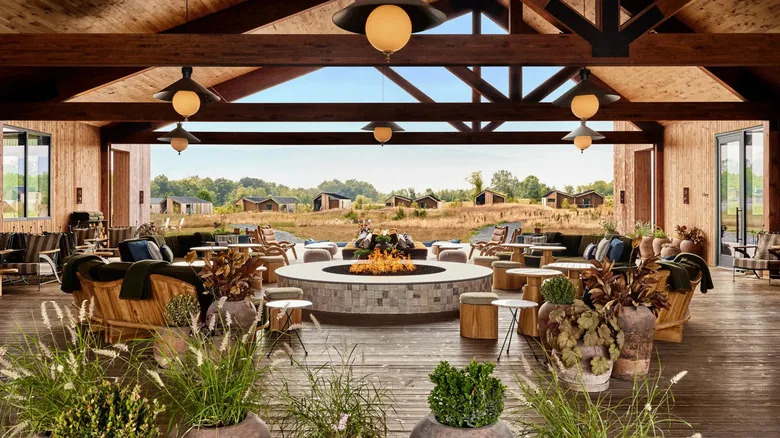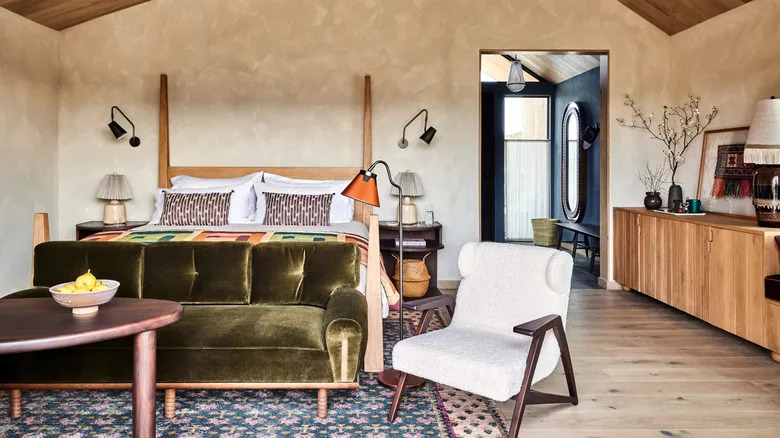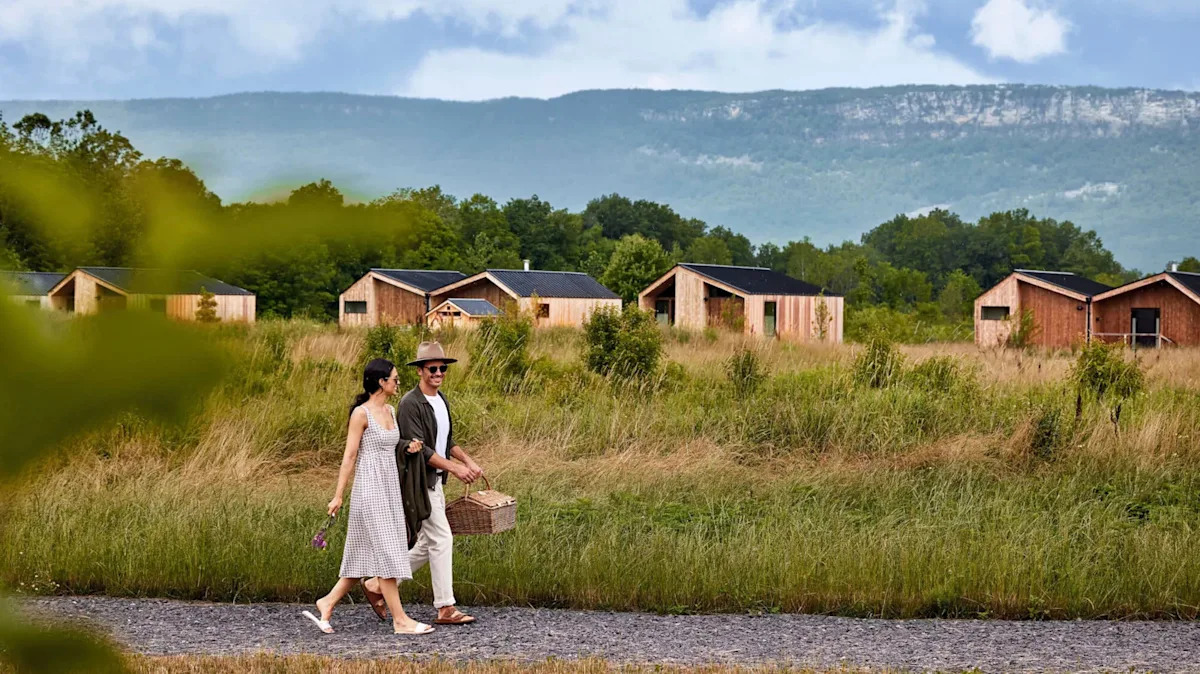There’s a reason New York’s Hudson Valley inspired an entire art movement. The hills, mountains, farms, orchards, and waterways that fill the 10 counties north of New York City are paintings in themselves, inspiring artists like Albert Bierstadt, Thomas Cole, and Frederic Edwin Church to capture the landscapes on canvas. Thankfully, more than 100 years later, the beauty of the valley still remains a draw, and hotels like Wildflower Farms in Gardiner immerse guests in it. In fact, as the name of the resort shows, Hudson Valley nature is incorporated into the experience. Outside, its 140 acres fills with flower meadows, wild woodlands, high cliffs, and views of Shawangunk Ridge, home to this New York state park with endless waterfalls, dense forest, and captivating cliff views.
Step inside, and the nature seems to come with you. That’s because the common areas, suites, and 65 freestanding cottages and cabins contain many of the elements, including reclaimed white oak ceilings, travertine countertops, slate showers, deep green upholstery, and other natural materials almost everywhere. Some spaces are open to nature almost entirely, most notably the Great Porch, which looks out to Shawangunk Ridge from the comfort of cushioned sofas and a communal fire pit. Indeed, so evocative and pleasing is the design — also influenced by Swiss and Dutch styles — that it won the Built Design Award for interior design in 2023, just a year after opening.
Read more: Essential Tips To Make A Rocky Mountain National Park Visit Affordable
Connecting with nature
The Great Porch at Wildflower Farms – Wildflower Farms, Auberge Resorts Collection
At Wildflower Farms, the goal is not just to enjoy nature, but reach out and touch it. To this end, the resort offers guests an extensive menu of activities and experiences. These include feeding the sheep and donkeys, mediating on forest walks, learning the art of floral arrangements, foraging produce from the 6-acre farm and then cooking it into dishes, mixing botanical cocktails, fly fishing, hand-building pressed-flower pottery, and hiking Minnewaska State Park and Mohonk Preserve — a New York mountain paradise with pristine lakes, trails, and extreme sports. This connection to nature runs all year long, too, with hiking boots turned into snowshoes in the winter and seasonal activities added for Halloween, Thanksgiving, and other holidays.
For all the effort, Wildflower Farms supplies rewards, too. Many of these can be found at the spa and its extensive nature-inspired treatments for the mind, body, and spirit. Among the signature ones are “Body Botany,” combining myofascial massage with steamed herbal poultices. “Valley Ritual” applies a botanical body scrub and soak in an herbal infused bath. These and other treatments are paired with the spa’s indoor saltwater pool and a 3,000-square-foot fitness center with classes daily. The indulgence extends to dining, too. Heavily sourced from the resort’s own gardens and other local farms, the new American cuisine covers breakfast, brunch, lunch, and dinner, with everything from olive oil pancakes to shakshuka to Hudson trout to Catskill duck breast. These are accompanied by “living elixirs” of fruit, vegetables, nuts, honey, bee pollen, and more.
Travel tips for Wildflower Farms
Interior of cabin at Wildflower Farms – Wildflower Farms, Auberge Resorts Collection
While Wildflower Farms may feel remote, it’s within easy distance of New York City and Albany, at about 80 miles to each. That puts four major airports close by — Albany International Airport to the north and LaGuardia Airport, JFK International Airport, and Newark Liberty International Airport to the south. New York Stewart International Airport is even closer at just 19 miles, although flight routes and airlines are much more limited. The nearest Amtrak station is in Poughkeepsie, 17 miles to the east. Buses also go to New Paltz, 7 miles away, but are car is ultimately necessary to reach the resort. That’s easy, too, as Interstate 87 runs right by, and there’s an exit at New Paltz, New York’s hippie town in the Hudson Valley with a European-style shopping street and artsy vibes.As with any trip into rural areas of New York, it’s important to account for the elements. This becomes even more important if intending to dive into the forests and mountains nearby, where rough trails require proper footwear, clothing, and equipment. This includes bug repellent, too, and careful checks for ticks after hikes, particularly during spring and early summer when they are active. Winters can be particularly harsh in the region, so it’s a good idea to bring layers of clothing to be ready for any conditions. Also, keep in mind that late winter and early spring, the snowmelt can create a lot of mud and even flood rivers.
Ready to discover more hidden gems and expert travel tips? Subscribe to our free newsletter for access to the world’s best-kept travel secrets.
Read the original article on Islands.
